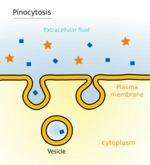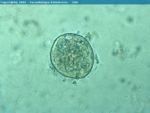Protozoa
Introduction
All protozoa are unicellular eukaryotic organisms which store their genetic information in chromosomes in a nuclear envelope. Protozoa are classified depending on their structure and life cycle. This reflects the similarities of the diseases which they cause. Protozoa belong to the Animal Kingdom (rather than the Plant Kingdom) as they obtain their energy through the intake of organic material.
Protozoa usually range from 10μm-50μm but can grow up to 1mm. Thus, they are usually observed and classified using a microscope.
Protozoa multiply sexually, asexually and can also use a combination of both, as seen in the coccidia class. Replication can be by binary or multiple fission. Different protozoa use different forms of motility, including flagella, cilia, pseudopodia and gliding.
Not all protozoa are harmful. For example, the rumen of ruminants and the caecum and colon of horses are full of symbiotic protozoa.
Structure and function
- Motile
- Protozoa possess all the 'usual' organelles which are found in most animal cells
- Nucleus, endoplasmic reticulum, mitochondria, Golgi bodies and lysosomes
- Protozoa also possess other cellular structures, organelles and sub-cellular structures which enable an independent existence to be led
- Cilia
- Fine, short hairs covering the protozoal surface each arising from a basal body
- Hairs beat in unison to enable the protozoa to move
- Wafts food towards the cytostome (mouth opening)
- E.g. Balantidium
- Flagellum
- Contractile fibre arising from a basal body
- Contracts in a whip like motion to propel protozoa
- Attached to body of some protozoa by an undulating membrane
- During movement, the organism's shape is maintained by microtubules in the pellicle
- E.g. Trypanosoma
- Pseudopodia
- Extensions of the cellular cytoplasm
- Cytoplasm flows into the pseudopodia allowing movement of the protozoa
- Also acts in a phagocytic manner surrounding food particles and enclosing it in a vacuole
- E.g. Entamoeba
- Gliding
- No obvious means of locomotion
- E.g. Eimeria
Nutrition and digestion
- Pinocytosis
- Droplets of fluid taken into the cell
- Generates small vesicles
- Usually used for extracellular fluid ingestion
- Requires ATP
- Phagocytosis
- Larger particles of matter taken into the cell
- Usually solid particles ingested
- Cell membrane envelops the fluid or food taking it into the cell
- Lysosomes fuse with the fluid/food vesicle initiating digestion
- Diffusion through the cell membrane allows excretion of metabolic products
Life Cycle
- Most protozoal reproduction is asexual via binary fission, schizogony and sporogony
- Some protozoa also use sexual reproduction called gametogony
- In some species, sexual and asexual reproduction occurs in the same host, whilst in others asexual reproduction occurs in the vertebrate host and sexual reproduction in the arthropod vector
- Homoxenous
- Parasite uses a single host species during its life cycle (direct)
- E.g. Eimeria
- Heteroxenous
- Parasite uses more than one host during its life cycle (indirect)
- E.g. Trypanosomes
- Facultatively heteroxenous
- Parasite may use more than one host during its life cycle but this is not essential
- E.g. Toxoplasma gondii
Example of a Protozoal Life Cycle
See Coccidia
Protozoa of Veterinary Importance
- Eimeria
- Isospora
- Babesia
- Cytauxzoon
- Theileria
- Neospora
- Sarcocystis
- Toxoplasma
- Leishmania spp.
- Trypanosoma spp.
- Balantidium
- Cyclospora
- Entamoeba
- Histomonas meleagridis
- Microsporidia
- Tritrichomonas foetus
Protozoa Flashcards
Useful Resources
Brilliant microscopic pictures of protozoa and helminths
Detailed information and images, including clincial signs and pathogenesis, of East Coast Fever
Useful online resource for diagnosing parasitic infections, courtesy of the Laboratory of Parasitology, University of Pennsylvania School of Veterinary Medicine


